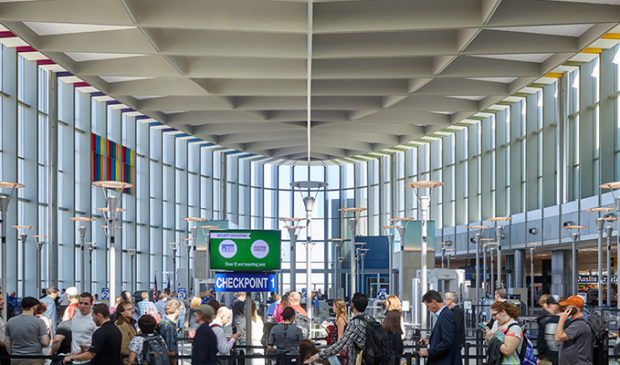Planning Commission votes in favor of protecting future ears from airport expansion
Thursday, October 3, 2019 by
Jessi Devenyns Generally speaking, residential use is prohibited within the airport overlay zones. The exception is the third zone (AO3) of the airport overlay, which under certain circumstances permits residential development.
“We don’t just meet one of the three thresholds, we meet two,” Drenner Group’s Amanda Swor told the Planning Commission at its Sept. 24 meeting. She was asking on behalf of the applicant to change the zoning from commercial to mixed-use in order to develop 390 units, 18 of which will be affordable at 60 percent of the median family income.
The three requirements are: The property has a recorded final plat on or before Aug. 20, 2001; is located in a neighborhood plan combining district on or before Dec. 31, 2001; and the development has a noise reduction/mitigation effort to achieve a noise reduction level of 25 db. According to Swor, the proposed project at 1501 Airport Commerce Drive was platted before 2001 and the development plans incorporate noise reduction controls into the building.
“Under (Federal Aviation Administration) regulations, this is a compatible use,” said Jeff Howard, who also spoke on behalf of the property owner. All compatible uses are allowed in airport overlay buffer zones, which is what the AO3 is intended to be, if the noise levels are at 65 decibels or below. “Even in the 65-70 decibel range, it is allowed if you provide noise level reduction,” Howard said.
To prove that the property met the third code requirement for development, noise tests were conducted for three consecutive days, and sound jumped above the decibel threshold in only five instances. Swor noted that during the tests, airplane noise was indistinguishable from the other environmental sounds, including traffic from Highway 183.
As it stands now, the third zone of the airport overlay is a protective buffer around the second zone, in which the city of Austin invested $20 million, in addition to $80 million from the FAA, to relocate residents. Although AO3 is currently buildable, Shane Harbinson with the city’s aviation department explained to commissioners that he expects the un-buildable AO2 zone to expand into the buffer as the airport continues to grow.
The level of growth he expects is double the traffic that the airport currently funnels down the runways in addition to becoming a destination for bigger, international airplanes. In simple terms that means a lot more noise, which he says will easily travel to the current AO3 zone. It is potentially also enough noise that residents who are now on the edges of the third zone will complain about noise to the point that further relocation grant assistance from the FAA will be necessary.
However, the ability to ask for this assistance in the future will be in jeopardy if the city allows for residential construction in what is now a buffer zone.
“I think there’s still a way for this development to be within the 65 decibels,” said Commission Chair Fayez Kazi.
Swor said that there were already plans for thicker glass windows and increased insulation to mitigate outdoor noise. She also pointed out that there is a multifamily unit under construction a stone’s throw away abutting Riverside Drive.
Harbinson explained that this development was part of the East Riverside Corridor plan and on the edge of the AO3 zone. The property in question at 1501 Airport Commerce Drive is completely within the overlay and designated as commercial in the Montopolis Neighborhood future land use map. These differing circumstances, he said, made him “obligated” to not support the zoning change.
The Montopolis Neighborhood Contact Team supported the zoning change with the condition that 5 percent of the 390 units will be available at 60 percent of median family income.
Commissioner James Shieh agreed that more residential units in this area would be desirable, but “the concern I have is the way Austin is trending … we don’t want to be in a situation where we’re buying people out all over again.”
After weighing the need for residential in the area against the risk of forfeiting future FAA grant money, the commission voted 8-3-2 to recommend that the development be denied. Kazi and commissioners Yvette Flores and Claire Hempel voted against the motion and commissioners Patricia Seeger and Carmen Llanes Pulido abstained.
Photo courtesy of the city of Austin.
The Austin Monitor’s work is made possible by donations from the community. Though our reporting covers donors from time to time, we are careful to keep business and editorial efforts separate while maintaining transparency. A complete list of donors is available here, and our code of ethics is explained here.
You're a community leader
And we’re honored you look to us for serious, in-depth news. You know a strong community needs local and dedicated watchdog reporting. We’re here for you and that won’t change. Now will you take the powerful next step and support our nonprofit news organization?




